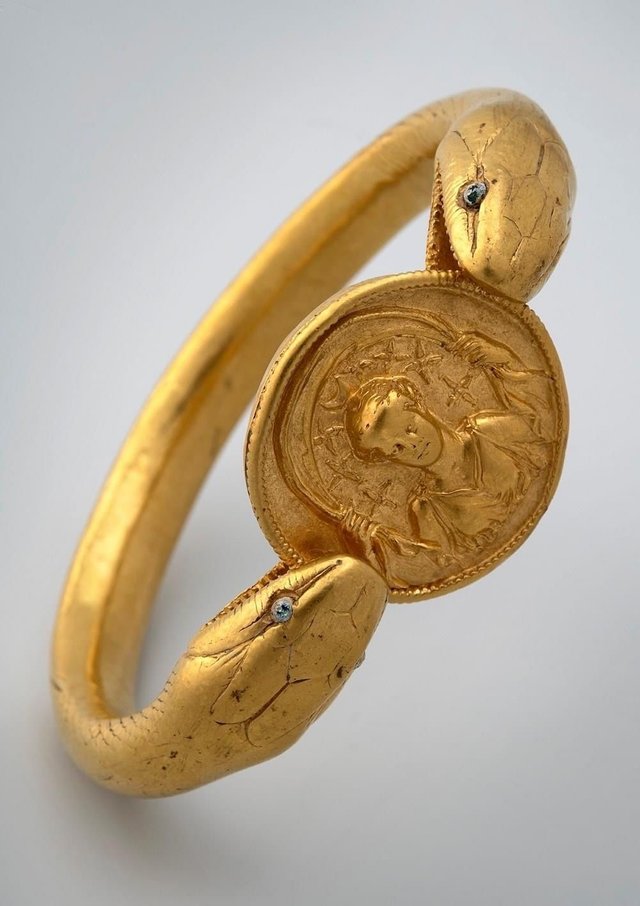The House of the Golden Bracelet
House of the golden bracelet, bracelet with snake heads holding disc with a bust of selene, 1st century AD. Picture Credit: Sailko Creative Commons Attribution-Share Alike 4.0 International license. Wikimedia Commons
Pompeii is a rich resource for archaeologists interested in Roman domestic architecture. In particular, it offers many examples of the standard high-status “atrium style” townhouses described by Vitruvius in “On Architecture”.
But Pompeii also offers examples that show this standard could be adapted to suit circumstances. The House of the Golden Bracelet, also known as the House of the Wedding of Alexander, is an example of an atrium-style layout adapted to local topography.
The Insula Occendentalis
The house occupies an area on the western edge of Pompeii known as the Insula Occendentalis. On one of its sides are the western city walls. On the other is the Via Consolare, one of the main roads of Pompeii leading towards the northern Herculaneum Gate.
Shops and businesses lined the road and behind them were several beautiful, high-status houses. This mixed commercial and domestic character was a common feature of Pompeii and many Roman cities. However, what makes the houses of the Insula Occendentalis particularly interesting is their unusual design. For to accommodate the sloping land and the city walls they were built against, many of them were multi rather than single story.
An Unusual Atrium House
The House of the Golden Bracelet is one of the largest and loveliest of these houses. Three stories high, the topography of the land meant that the upper story was at street level, so this was the location of the entry point for the house.
Consequently, this upper floor was laid out in the same way as a standard for an atrium house. The fauces or entrance corridor opened out on an atrium surrounded by the usual array of rooms on all but the southernmost side.
Usually, in an atrium-style house, the tablinum offered glimpses of the peristyle and the private zone of the house. However, in the House of the Golden Bracelet, this private area was not behind the tablinum but below it.
The Wedding of Alexander
The private zone was located on the house’s middle floor, reached by a broad flight of stairs next to the tablinum. The general theme of this floor is entertainment and leisure. The house’s bath suite was located here, as well as a series of reception and dining rooms.
The layout, vistas and decoration of these rooms would have made a lavish impact on guests. Instead of opening out into a peristyle garden, the rooms looked down onto the garden below. The main dining room was vaulted and painted with fashionable murals. One, the wedding of Alexander the Great and Roxanne, gave the house its initial name: the House of the Wedding of Alexander.
On the south side of this floor were the kitchen and service area. Next to this was a narrow flight of stairs leading to the lower level of the house.
Gardens and Mystery Cults
The garden on the house’s ground floor was laid out in a formal design. Root cavities suggest elaborate box hedges surrounded the flower beds. But the edge of the garden nearest to the house was dominated by water features. A blue-painted pool and fountain, surrounded by a pergola, formed a focal point that tied the garden in with the central room of the lower story: the summer triclinium.
The main feature of the summer triclinium was a nymphaeum or fountain situated in an apse at the back of the room. Water from the fountain ran down a series of steps to flow through a channel between the marble dining couches. The water then drained out into the pool in the garden, where it rose again from a central fountain and 28 side jets.
The triclinium was the site of some lavish meals. Bones of fish, chicken, lamb, beef, pig, partridge and shellfish have been found nearby. But the garden rooms were not just used for entertainment. Next door to the triclinium was a room decorated with murals of birds and plants. They also incorporated symbols of the Greek god Dionysus. This suggests that the room could have been a sacraria or cult room to the god.
The Last Residents
In 1974, some of the house’s last occupants were discovered at the base of the ground floor stairs. Casts were made around the bodies, revealing two children, a man and a woman. This young family was killed early on the final day of the eruption of 79 AD.
Scattered around the bodies were jewellery and over 200 gold and silver coins, indicating they were people of means. But the most striking find was discovered on the body of the woman. This was a solid gold double-headed snake bracelet that weighed 1.33lbs — so spectacular that it eclipsed even the murals of the wedding on the middle floor and earned the house its new name.
Resources
Dobbins, J J and Foss, P W, (eds) (2008) “The World of Pompeii“. Routledge: London and New York.
Deem, James, M, (2005) “Bodies From the Ash: Life and Death in Ancient Pompeii”. Houghton Mifflin Company: Boston
